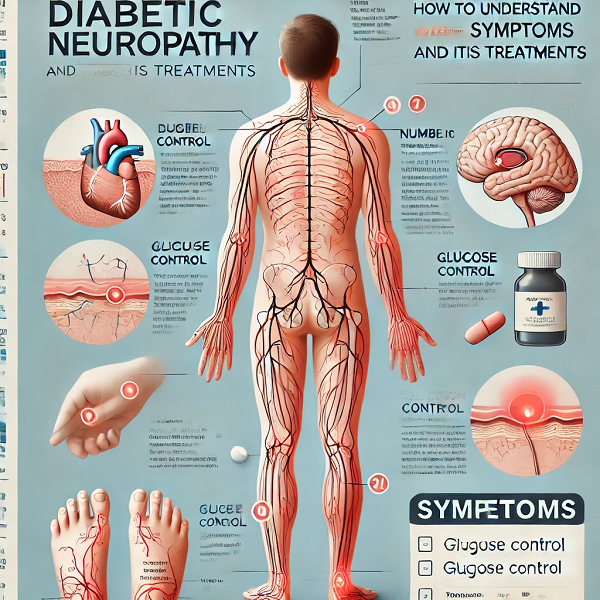Diabetic neuropathy is a type of nerve damage that can occur if you have diabetes. High blood sugar (glucose) can injure nerves throughout your body. Diabetic neuropathy most often damages nerves in your legs and feet.
What is Diabetic Neuropathy?
Diabetic neuropathy is a serious and common complication of type 1 and type 2 diabetes. It’s a type of nerve damage caused by long-term high blood sugar levels. The condition usually develops slowly, sometimes over several decades. If you have diabetes and notice numbness, tingling, pain, or weakness in your hands or feet, you should see your healthcare provider. These are the early symptoms of peripheral neuropathy. In cases of severe or prolonged peripheral neuropathy, you may be vulnerable to injuries or infections. In serious cases, poor wound healing or infection can lead to amputation.
Symptoms of Diabetic Neuropathy
The symptoms of diabetic neuropathy depend on the type of neuropathy and which nerves are affected. Some people may not experience any symptoms, while others may have:
- Numbness, tingling, or pain in the toes, feet, legs, hands, arms, and fingers
- Wasting of the muscles of the feet or hands
- Indigestion, nausea, or vomiting
- Diarrhea or constipation
- Dizziness or faintness due to a drop in blood pressure after standing or sitting up
- Problems with urination
The most common type of diabetic neuropathy is peripheral neuropathy, particularly affecting the feet and legs.
Causes and Risk Factors
High blood sugar levels over a long period can cause diabetic neuropathy. Other factors can also contribute to nerve damage, including:
- Blood vessel damage due to high cholesterol levels
- Mechanical injury, such as injuries from carpal tunnel syndrome
- Lifestyle factors, such as smoking or alcohol use
- Neuropathies triggered by autoimmune diseases
Diagnostic Approaches
Diagnosing diabetic neuropathy involves a physical exam and a review of symptoms. Healthcare providers may also conduct:
- Nerve conduction studies
- Electromyography (EMG)
- Blood tests
- Urine tests
- Imaging tests, such as CT scans or MRI
Early diagnosis and treatment are crucial for preventing irreversible nerve damage.
Treatment and Management
There is no cure for diabetic neuropathy, but treatment can slow its progression, reduce pain, and manage complications. Treatment strategies include:
- Tight glucose control to slow the progression of neuropathy
- Pain relievers, anti-seizure medications, and antidepressants for pain management
- Treatments for other symptoms, such as gastrointestinal problems, urinary issues, and dizziness
Lifestyle modifications can also help manage symptoms, including:
- Regular exercise
- Healthy eating
- Smoking cessation
- Limiting alcohol consumption
Physical therapy can help improve muscle strength, coordination, and reduce pain.
Prevention Strategies
Preventing diabetic neuropathy involves controlling blood sugar levels, but other measures can also help, such as:
- Regular check-ups with healthcare providers
- Foot care, including daily inspection and proper footwear
- Blood pressure management
- Weight control through diet and exercise
Living with Diabetic Neuropathy
Living with diabetic neuropathy requires adjustments to manage symptoms and prevent complications. Patients are advised to monitor their blood sugar levels regularly, adhere to their treatment regimen, and maintain a healthy lifestyle. Regular visits to healthcare providers for check-ups are also essential.
Diabetic neuropathy is a preventable and manageable condition with the right treatment and lifestyle adjustments. By understanding the symptoms and treatments available, individuals can lead a healthier life.
References
- Kaiser Permanente offers a comprehensive overview of various health conditions, including diabetes and its complications like diabetic neuropathy. They provide resources for managing diabetes effectively, which could be crucial for preventing or managing diabetic neuropathy. Learn more from Kaiser Permanente.
- Harvard Health has a broad range of articles related to health, including pieces that address nerve damage associated with diabetes. Their content is typically grounded in current research and written by health professionals. Explore Harvard Health.
- Purdue OWL (Online Writing Lab), while not directly related to diabetic neuropathy, is an excellent resource for understanding how to properly format academic papers, which could be useful if you are preparing to write or cite articles on diabetic neuropathy. Visit Purdue OWL.
- College Board provides a host of educational and resourceful articles, which might include topics on health education and awareness that could indirectly relate to understanding diabetic neuropathy as part of broader health education initiatives. Check out College Board
#DiabeticNeuropathy #DiabetesAwareness #NerveDamage #NeuropathyTreatment #ChronicPain #BloodSugarControl #PeripheralNeuropathy #HealthyLiving #PainManagement #DiabetesCare








I couldn’t leave your website without mentioning how much I appreciated the quality of information you provide to your visitors. I’ll be returning regularly to check for new posts.